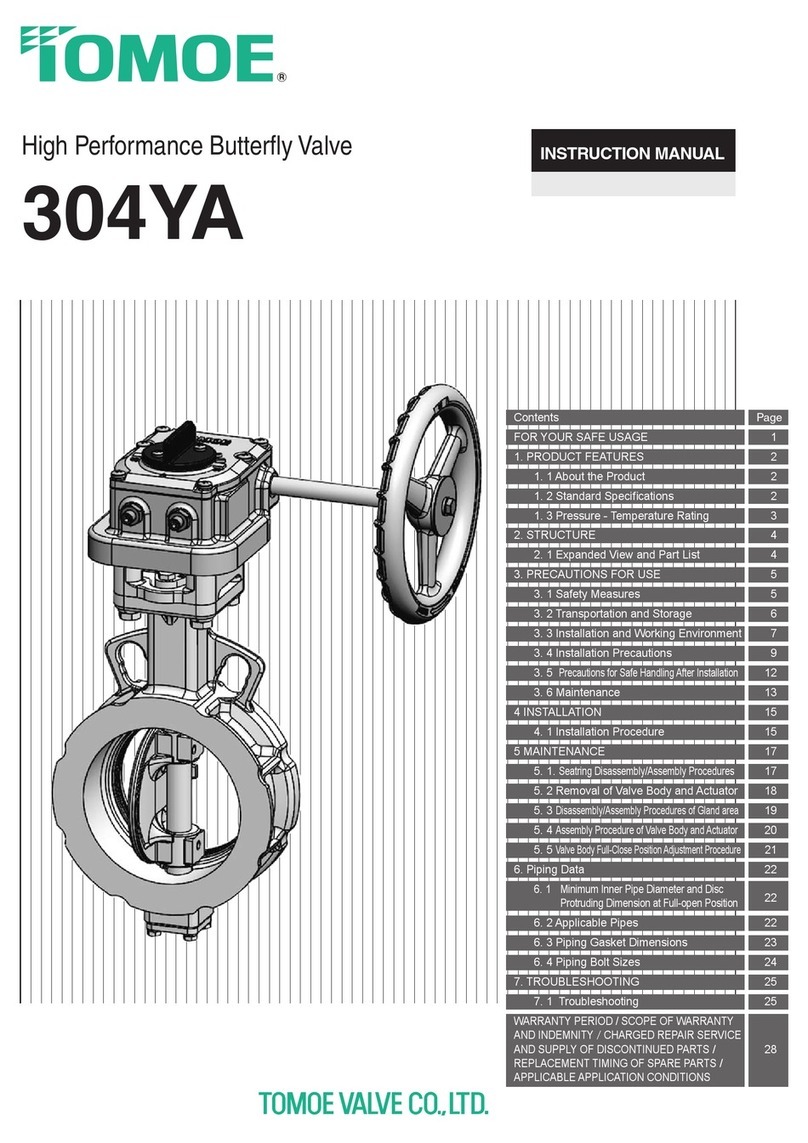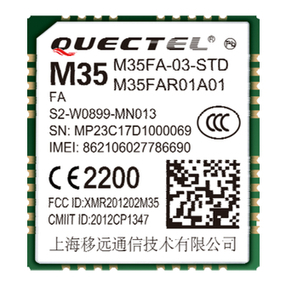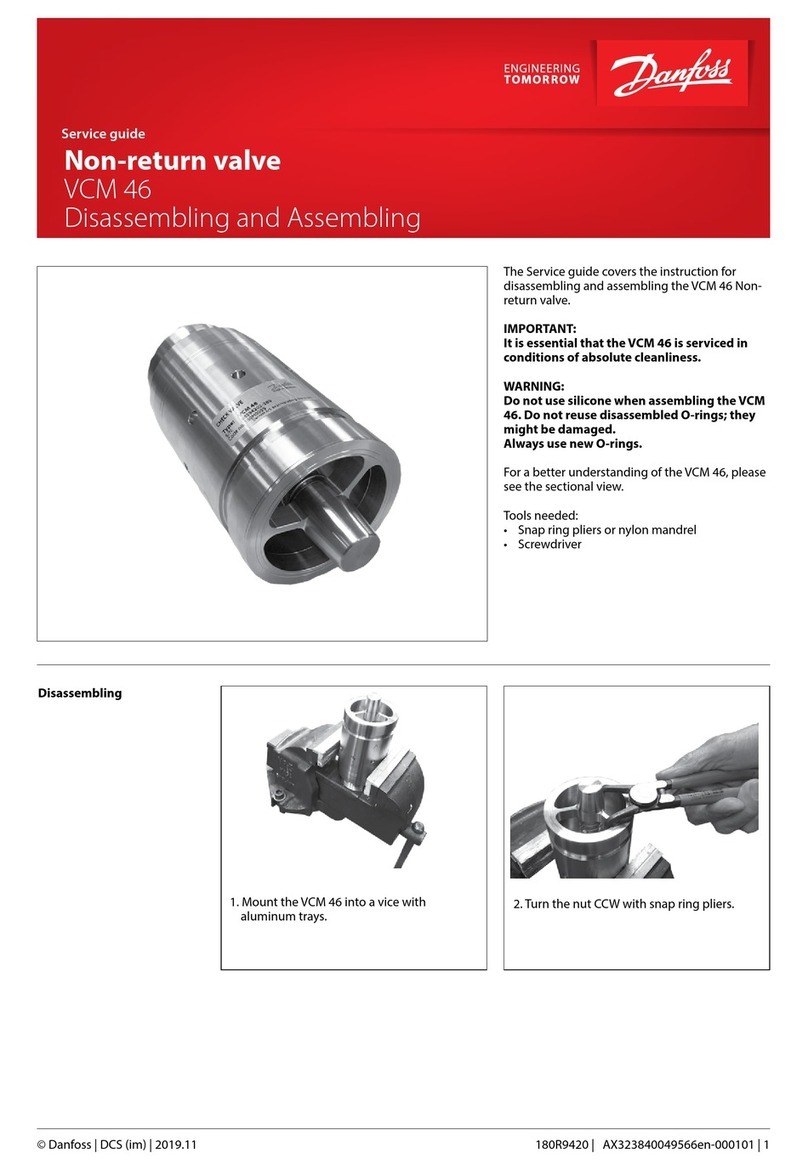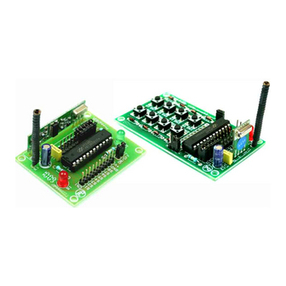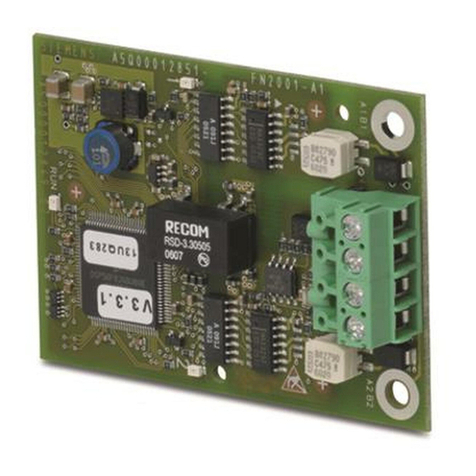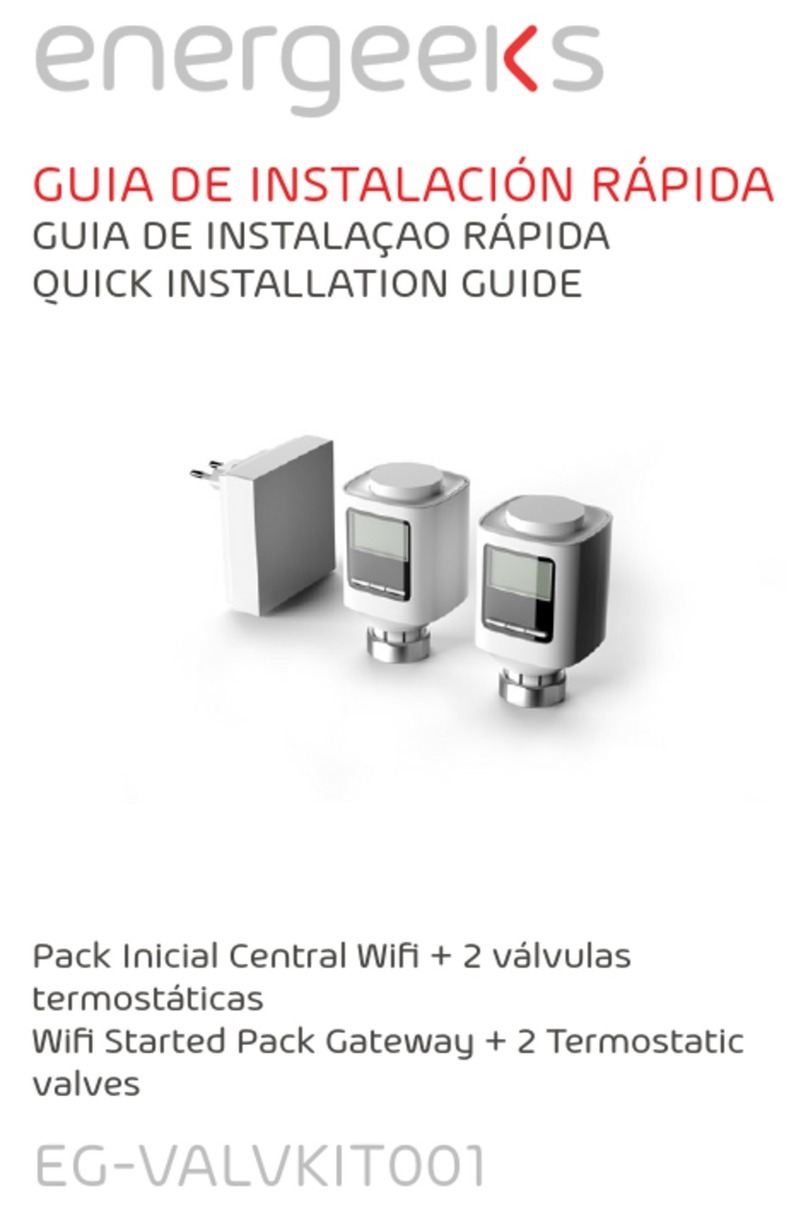Tomoe MKT Series User manual

MKT Series Standard Specifications
Expanded View
Precaution for Use
Installation Procedure
Precautions for Safe Handling After Installation
Inspection and Countermeasures
Disassembly/Assembly Procedures
Pressure Loss, Flow Characteristics
Valve Specifications and Standards for Selecting Springs
Available Pipe List
Cracking Pressure (Opening Pressure)
Quantity and Dimensions of Piping Bolts
Before Placing an Order
2
3
4
10
12
12
13
18
19
20
21
21
22
Contents Page
(907T・908H)

MKT Series Standard Specifications
Valve structure
Valve nominal diameter
Valve type
Applicable flange standard
Face-to-face dimensions
Max. working pressure
Allowed flow velocity
Allowable valve seat
leakage standard
Test
pressure
Working temperature range
(without freezing)
Standard
materials
Pipe gasket
Coating
Pressure
resistance
of body
Valve seat
leakage
Main body*2
Plate
Pin
Spring
Seat*3
Wafer-type double-plate check valve
Check valve with bypass
JIS 10K, 16K, 20K ASME B16.5 Class125/150
JV8-1 (stainless steel valves, wafer-type check valves), SAS358
2.0MPa
0.5 m/s to 10 m/s (Max. 12 m/s)
Tight shut
3.0MPa
High-pressure test 2.2 MPa (hydraulic)
A351 CF8 (stainless cast steel)
304 stainless steel
304 stainless steel
NBR, EPDM
Required (please purchase a commercially available gasket that satisfies the flange standards)
907T = Resin baked finish (Tomoe Green)
908H = No coating
NBR seat
EPDM seat
: 0 to 60℃
: 0 to 100℃
907T
50, 65, 80, 100, 125, 150, 200, 250, 300, 350, 400 mm
*1
908H
50, 65, 80, 100, 125, 150, 200, 250, 300 mm
A536 Gr.65-45-12 (ductile cast iron) A351 CF8 (equivalent to SCS13)
*1. 250A and 300A types include rubber sleeves. (Compared to the types without rubber sleeves, loss of pressure increases by approx. 8%.)
350mm & 400mm do not include bypass as a rule, and are made to order. Please contact our sales team.
*2. The rubber seat is vulcanized to the valve body valve seat surface.
*3.
With fluid containing chlorine, the seat ring may deteriorate earlier than expected, depending on the concentration and temperature conditions.
Please contact our sales team for details.
* Never use an EPDM rubber seat if the valve is being used for oil or for a fluid containing even a trace of oil.
When a chemical agent containing calcium is charged to protect the piping, EPDM seat ring is recommended.
Incorrect selection of the valve specifications according to the fluid conditions and installation conditions may
cause vibration noise during operation.
Refer to "MKT Valve Specifications and Standards for Selecting Springs" and "Handling Precautions".
2
FOR YOUR SAFETY IN USE The following instructions should always be followed.
Warning This sign indicates “possibility of death or serious injury”.
This symbol indicates items that "you must not do".
This symbol indicates items "you must do".
This sign indicates “possibility of injury to personnel or
physical damage to property only”.
■The levels of danger and damage when these cautions are neglected and the
product is used incorrectly are classified and described below.
■
The types of advisories to be observed are classified and indicated with the symbols below
(The following symbols are examples.)
Caution
■Introduction
1
Thank you for purchasing our products.
For proper use of our products over long periods of time, please read this instruction manual thor-
oughly before use, and use the products properly in accordance with its contents.
The instructions in this document are to promote the correct use of the check valve MKT series
(hereinafter "this product") and to help prevent injury or damage.
●Be sure to read this instruction manual before transportation, storage, piping and installation, operation, mainte-
nance and inspection.
●This instruction manual does not describe all the assumed conditions concerning transportation, storage,
installation, operation, maintenance and inspection of this product. If there are any questions, please contact
our sales representative.
●Reference values and limit values for operation, maintenance and inspection, which are specified in this
instruction manual, have been determined in consideration of maintenance management of this product. This
product should be used within the range of the reference values and the limit values.
●Be sure to store this instruction manual in a readily accessible place for future reference after installation and
when operation starts.
If a staff member in charge is changed, information concerning the storage place of this document and opera-
tion should be given to the member of staff taking over responsibility.
●If dents or scratches are caused by an impact, etc., for safety’s sake you should stop using and replace the
product.
●The contents of this instruction manual are subject to change without notice.

MKT Series Standard Specifications
Valve structure
Valve nominal diameter
Valve type
Applicable flange standard
Face-to-face dimensions
Max. working pressure
Allowed flow velocity
Allowable valve seat
leakage standard
Test
pressure
Working temperature range
(without freezing)
Standard
materials
Pipe gasket
Coating
Pressure
resistance
of body
Valve seat
leakage
Main body*2
Plate
Pin
Spring
Seat*3
Wafer-type double-plate check valve
Check valve with bypass
JIS 10K, 16K, 20K ASME B16.5 Class125/150
JV8-1 (stainless steel valves, wafer-type check valves), SAS358
2.0MPa
0.5 m/s to 10 m/s (Max. 12 m/s)
Tight shut
3.0MPa
High-pressure test 2.2 MPa (hydraulic)
A351 CF8 (stainless cast steel)
304 stainless steel
304 stainless steel
NBR, EPDM
Required (please purchase a commercially available gasket that satisfies the flange standards)
907T = Resin baked finish (Tomoe Green)
908H = No coating
NBR seat
EPDM seat
: 0 to 60℃
: 0 to 100℃
907T
50, 65, 80, 100, 125, 150, 200, 250, 300, 350, 400 mm
*1
908H
50, 65, 80, 100, 125, 150, 200, 250, 300 mm
A536 Gr.65-45-12 (ductile cast iron) A351 CF8 (equivalent to SCS13)
*1. 250A and 300A types include rubber sleeves. (Compared to the types without rubber sleeves, loss of pressure increases by approx. 8%.)
350mm & 400mm do not include bypass as a rule, and are made to order. Please contact our sales team.
*2. The rubber seat is vulcanized to the valve body valve seat surface.
*3.
With fluid containing chlorine, the seat ring may deteriorate earlier than expected, depending on the concentration and temperature conditions.
Please contact our sales team for details.
* Never use an EPDM rubber seat if the valve is being used for oil or for a fluid containing even a trace of oil.
When a chemical agent containing calcium is charged to protect the piping, EPDM seat ring is recommended.
Incorrect selection of the valve specifications according to the fluid conditions and installation conditions may
cause vibration noise during operation.
Refer to "MKT Valve Specifications and Standards for Selecting Springs" and "Handling Precautions".
2
FOR YOUR SAFETY IN USE The following instructions should always be followed.
Warning This sign indicates “possibility of death or serious injury”.
This symbol indicates items that "you must not do".
This symbol indicates items "you must do".
This sign indicates “possibility of injury to personnel or
physical damage to property only”.
■The levels of danger and damage when these cautions are neglected and the
product is used incorrectly are classified and described below.
■
The types of advisories to be observed are classified and indicated with the symbols below
(The following symbols are examples.)
Caution
■Introduction
1
Thank you for purchasing our products.
For proper use of our products over long periods of time, please read this instruction manual thor-
oughly before use, and use the products properly in accordance with its contents.
The instructions in this document are to promote the correct use of the check valve MKT series
(hereinafter "this product") and to help prevent injury or damage.
●Be sure to read this instruction manual before transportation, storage, piping and installation, operation, mainte-
nance and inspection.
●This instruction manual does not describe all the assumed conditions concerning transportation, storage,
installation, operation, maintenance and inspection of this product. If there are any questions, please contact
our sales representative.
●Reference values and limit values for operation, maintenance and inspection, which are specified in this
instruction manual, have been determined in consideration of maintenance management of this product. This
product should be used within the range of the reference values and the limit values.
●Be sure to store this instruction manual in a readily accessible place for future reference after installation and
when operation starts.
If a staff member in charge is changed, information concerning the storage place of this document and opera-
tion should be given to the member of staff taking over responsibility.
●If dents or scratches are caused by an impact, etc., for safety’s sake you should stop using and replace the
product.
●The contents of this instruction manual are subject to change without notice.

Precaution for Use
1. Handling of this product
Safety Measures
4
(1) This product should be assembled, operated, maintained, etc. by personnel who have read the
instruction manual (hereinafter "this document") thoroughly and understood the contents well.
(2) The work should be performed while wearing protective gear, such as a helmet, safety belt, protective
glasses, working gloves and safety shoes, in accordance with laws and regulations, and safety
provisions of business establishments.
(3) Do not stand or place heavy objects on this product, as this may cause the product to be damaged,
resulting in falling accidents.
2. Safety check
Never attempt to handle the machine and the system or remove the equipment before safety is ensured.
Before removing the equipment, check the following items are in place to ensure safety.
(1) Safety precautions for this product have been taken, such as prevention of falling of any parts or
materials, or other accidental events.
(2) The surface temperatures of this product, flanges, and pipes are at a safe level for surfaces to be
touched.
(3) The pressure in the piping is atmospheric pressure, and fluid has been drained from the interior of the
piping.
(4) Where the fluid flowing through the piping is toxic, flammable or corrosive, adequate safety measures
have been taken.
(5) Energy sources for the facilities related to this product, such as power supplies and air sources, have
been shut off.
(6) No fluid harmful to the human body is adhering to the product or to the peripheral piping.
Before restarting the unit, check the following items.
(1) There is no failure or damage to this product visible, and no parts are missing.
(2) No tools have been left on this product or on the pipes.
(3) Nothing can hinder operation of this product.
(4)
A safe evacuation procedure is already in place in case of unexpected equipment movement, leakage, etc.
3. Water hammer
This product can be used with the purpose of preventing water hammer due to water level reduction, by
closing the valve when the pump is stopped. However, water hammer may still occur, depending on
installation conditions such as opening/closing operations of other valves and piping height from the ground.
Design should take into account prevention of water hammer.
Occurrence of water hammer may damage this product and the peripheral piping materials.
4. Cavitation
Design should take into account prevention of cavitation.
This product can be operated at a maximum fluid velocity of 10m/s. However, cavitation may occur when
the product is used at a velocity of 10m/s or less. If abnormal noise or vibrations are generated by the
product or peripheral piping during fully-open operation, cavitation may have occurred. If the product is
used for long periods of time in this state, the product or piping materials may be damaged. Cavitation
should therefore be prevented, by changing the flow rate, etc.
Warning
Warning
Caution
Caution
7
26
4
5
99
10
1
8
9
30
30
8
9
6
26
7
3
2L
2R
16
51
20
13
12
29
23
21
15
15 14
9
30
30
9
■MKT Body Parts List (50 to 300 mm)
No. Q'ty RemarksPart Name
1
2L
2R
3
4
5
6
7
8
9
10
12
13
14
15
16
20
21
23
26
29
30
51
99
Body
Left plate
Right plate
Spring
Hinge pin
Stop pin
Seat
Hexagon nut
Washer
Washer
Eye bolt
Handle
Lock bolt
Stopper
Hexagon socket set screw
O-ring
Spindle
Hexagon nut
Collar
Seal washer
Spring washer
Bearing
Rubber valve seat
Rubber sleeve
1
1
1
1
1
1
1
4
2
4
1
1
1
1
2
1
1
1
1
4
1
4
1
1
200, 250, 300 mm:2 pcs
Same part as part No. 4.
Vulcanized to body
Only 150, 200, 250, 300 mm
Only 250, 300 mm
3
Expanded View

Precaution for Use
1. Handling of this product
Safety Measures
4
(1) This product should be assembled, operated, maintained, etc. by personnel who have read the
instruction manual (hereinafter "this document") thoroughly and understood the contents well.
(2) The work should be performed while wearing protective gear, such as a helmet, safety belt, protective
glasses, working gloves and safety shoes, in accordance with laws and regulations, and safety
provisions of business establishments.
(3) Do not stand or place heavy objects on this product, as this may cause the product to be damaged,
resulting in falling accidents.
2. Safety check
Never attempt to handle the machine and the system or remove the equipment before safety is ensured.
Before removing the equipment, check the following items are in place to ensure safety.
(1) Safety precautions for this product have been taken, such as prevention of falling of any parts or
materials, or other accidental events.
(2) The surface temperatures of this product, flanges, and pipes are at a safe level for surfaces to be
touched.
(3) The pressure in the piping is atmospheric pressure, and fluid has been drained from the interior of the
piping.
(4) Where the fluid flowing through the piping is toxic, flammable or corrosive, adequate safety measures
have been taken.
(5) Energy sources for the facilities related to this product, such as power supplies and air sources, have
been shut off.
(6) No fluid harmful to the human body is adhering to the product or to the peripheral piping.
Before restarting the unit, check the following items.
(1) There is no failure or damage to this product visible, and no parts are missing.
(2) No tools have been left on this product or on the pipes.
(3) Nothing can hinder operation of this product.
(4)
A safe evacuation procedure is already in place in case of unexpected equipment movement, leakage, etc.
3. Water hammer
This product can be used with the purpose of preventing water hammer due to water level reduction, by
closing the valve when the pump is stopped. However, water hammer may still occur, depending on
installation conditions such as opening/closing operations of other valves and piping height from the ground.
Design should take into account prevention of water hammer.
Occurrence of water hammer may damage this product and the peripheral piping materials.
4. Cavitation
Design should take into account prevention of cavitation.
This product can be operated at a maximum fluid velocity of 10m/s. However, cavitation may occur when
the product is used at a velocity of 10m/s or less. If abnormal noise or vibrations are generated by the
product or peripheral piping during fully-open operation, cavitation may have occurred. If the product is
used for long periods of time in this state, the product or piping materials may be damaged. Cavitation
should therefore be prevented, by changing the flow rate, etc.
Warning
Warning
Caution
Caution
7
26
4
5
99
10
1
8
9
30
30
8
9
6
26
7
3
2L
2R
16
51
20
13
12
29
23
21
15
15 14
9
30
30
9
■MKT Body Parts List (50 to 300 mm)
No. Q'ty RemarksPart Name
1
2L
2R
3
4
5
6
7
8
9
10
12
13
14
15
16
20
21
23
26
29
30
51
99
Body
Left plate
Right plate
Spring
Hinge pin
Stop pin
Seat
Hexagon nut
Washer
Washer
Eye bolt
Handle
Lock bolt
Stopper
Hexagon socket set screw
O-ring
Spindle
Hexagon nut
Collar
Seal washer
Spring washer
Bearing
Rubber valve seat
Rubber sleeve
1
1
1
1
1
1
1
4
2
4
1
1
1
1
2
1
1
1
1
4
1
4
1
1
200, 250, 300 mm:2 pcs
Same part as part No. 4.
Vulcanized to body
Only 150, 200, 250, 300 mm
Only 250, 300 mm
3
Expanded View

6
Installation and Working Environment
1. Installation location and working environment
In installation locations, sufficient work space should be planned and provided for anticipated work and mainte-
nance.
In certain installation locations or working environments there may be extra requirements, such as compliance with
laws and regulations, as well as functional conformance to specifications. If there are any questions, please
contact our sales team at the planning stage. These special installation environments may include:
(1)Special working environments which are not specified in the specifications
(2)Environments where failure of the product would be expected to cause substantial damage to human beings,
assets, surroundings etc.
e.g.: Facilities covered by the High Pressure Gas Safety Act, facilities covered by the Industrial Safety and Health
Act, Nuclear power related facilities, vehicles, medical facilities, etc.
2. Atmosphere of installation location
The following measures should be taken, depending on the atmosphere of the installation location for this product.
(1)Locations which are exposed to salt-laden atmospheres, corrosive gases, chemical solutions, organic solvents,
steam, salt water, etc. should be avoided.
(2)If there is a possibility that this product may be exposed to direct radiant heat or chemicals, the product and its
attachments should be protected with covers.
(3)Do not submerge this product. If it is installed in a place that is regularly exposed to water, such as near a
cooling tower, protect the product and its attachments with covers.
3. Temperature of installation location
Using this product out of the allowable working temperature range causes thermal degradation or hardening of
seat rings and O-rings, faulty operation due to thermal expansion of parts or differential thermal contraction, etc.
(1)The ambient temperature of the installation location should be within the ambient temperature range of 0°C to
60°C.
(2)If this product is exposed to direct sunlight, ensure that the working temperature remains below the upper limit
of the above ambient temperature range.
(3)This product should be kept away from heat sources, and should be installed in a location whose temperature
is within the specified ambient temperature range. Please note that siting the product near a motor, an engine,
an air compressor, a boiler, etc. may cause conditions to exceed the specified ambient temperature range.
4. Vibration and shock at installation location
The following measures should be taken if vibration or shock are factors at the installation location of this product.
(1)When this product is used in the following conditions, check for factors potentially causing vibration or shock,
such as acceleration values, and consult our sales team.
1) Locations where excessive vibration or shock is anticipated
2) Locations where vibration or shock is exerted regularly or continuously
(2)Mounting and connecting sections of this product should be secured to prevent loosening as a result of
vibration or shock.
(3)Anti-vibration measures should be taken to isolate or reduce vibration or shock to the machine. Piping should
be secured with firm supports, and where necessary vibration isolation materials should be used.
(4)Connections should be checked periodically for looseness or deformation. If there is any abnormality, the bolts
should be re-tightened or the parts should be replaced. A bolt working loose may cause the product to fall or
rotate suddenly in an unexpected direction.
Warning
Caution
Caution
1. Transportation and Transfer
Transportation and Storage
[Fig.-1]
5
(1)Products with large mass (150 mm or more) should be transported using suitable equipment or machinery, not by manpower alone.
See the catalog, product drawings, etc. issued by our company for details on the mass of this product. Qualified personnel should
perform work with a forklift, crane or sling in accordance with laws and regulations, and safety provisions of business establishments.
In addition, please observe the instructions in "Dropping and falling” below.
(2)While transporting this product, be careful not to damage the coated surface. If the surface is damaged, repair the coated film.
Leaving surface damage unrepaired may result in corrosion.
(3)Use shipping containers for ocean transportation. If the product is not sealed within a shipping container, it will deteriorate from
contact with salt-laden wind and spray.
(4)Use a covered vehicle for inland transportation to avoid exposure to wind and rain. If an open vehicle is used, cover the product with
a protective tarpaulin and secure against the effects of weather.
(5)Do not throw the product and do not apply a heavy load.
(1)When lifting or using a sling to hoist this product, pay thorough attention to safety. For example, check the mass well in advance, and
use lifting machinery or equipment rated to be safe for the mass. Ensure that no personnel ever stand or walk under or close to a
suspended load.
(2)Lighting during transportation must be sufficient to ensure safe operation, including lighting related to scaffolding to ensure its safe
use. The stability of piping must be ensured before any work takes place on it.
(3)During unloading or transportation between warehouses, this product should be secured properly at all times to prevent it from falling
and sustaining or causing damage.
(4)Do not use the product’s handle to suspend or hoist this product. The handle may break off or fail and the product may be damaged,
which is very dangerous.
If the nominal diameter of this product is 150 mm or more, use the hanger ring on the MKT body for hook attachment when hoisting.
(1)If the nominal diameter of this product is 50 mm to 200 mm, the product is packed in a cardboard box. For other products, protective
panels made of materials such as plywood are attached to the flange faces (pipe flange contact faces) of the body to protect the
interior.
(2)For the FCD body, rust prevention oil is applied thinly to the inner face of the body.
(3)A name plate is attached. Nominal diameter, materials, etc. can be checked on the plate.
Unpack this product only when ready to connect it to the piping. Do not leave the product unpacked for long periods of time. This will
prevent adherence of dust and harmful aerosols, and deterioration due to ozone or ultraviolet rays.
Otherwise, degradation in performance of this product, contamination, discoloration or materials deterioration may occur.
Store this product as follows to prevent its degradation in performance, contamination, discoloration, and material deterioration.
Store this product in a place with no dust or water droplets while avoiding direct sunlight, high temperatures and excessive humidity.
(1)Store this product in a cool and dark indoor area (ambient temperature:
-10°C - 40°C, humidity: 70% or less) without removing the cardboard
packaging or the protective material attached to the valve body.
[Fig.-1]
(2)With cardboard packaging, high humidity may reduce the strength of
the box and the packaging may deteriorate or separate, which may
result in damage to the product. Be careful not to let the packaging
become damp or wet.
(3)Do not store this product in an atmosphere that contains corrosive gas.
Otherwise, the parts may be subject to corrosion, resulting in an
impairment of functions.
(4)Do not drop or overturn this product or subject it to vibration, and do
not apply a heavy load to the product during storage. Otherwise,
functions may be impaired.
(5)Do not stack more than one item when storing this product. A load
collapse may occur, which could cause damage to personnel and/or
the product. (Refer to Transportation and Storage Section 2: "Dropping
and Falling".)
(6) Individual parts of this product, such as the handle, axle shaft etc., are
not designed to carry the weight of the valve. The products must be
stored so that no load is applied to such parts. Otherwise, the handle,
axle shaft, etc. may become deformed or fail.
2. Dropping and falling
3. Packing state
4. Unpacking
5. Storage
Warning
Warning

6
Installation and Working Environment
1. Installation location and working environment
In installation locations, sufficient work space should be planned and provided for anticipated work and mainte-
nance.
In certain installation locations or working environments there may be extra requirements, such as compliance with
laws and regulations, as well as functional conformance to specifications. If there are any questions, please
contact our sales team at the planning stage. These special installation environments may include:
(1)Special working environments which are not specified in the specifications
(2)Environments where failure of the product would be expected to cause substantial damage to human beings,
assets, surroundings etc.
e.g.: Facilities covered by the High Pressure Gas Safety Act, facilities covered by the Industrial Safety and Health
Act, Nuclear power related facilities, vehicles, medical facilities, etc.
2. Atmosphere of installation location
The following measures should be taken, depending on the atmosphere of the installation location for this product.
(1)Locations which are exposed to salt-laden atmospheres, corrosive gases, chemical solutions, organic solvents,
steam, salt water, etc. should be avoided.
(2)If there is a possibility that this product may be exposed to direct radiant heat or chemicals, the product and its
attachments should be protected with covers.
(3)Do not submerge this product. If it is installed in a place that is regularly exposed to water, such as near a
cooling tower, protect the product and its attachments with covers.
3. Temperature of installation location
Using this product out of the allowable working temperature range causes thermal degradation or hardening of
seat rings and O-rings, faulty operation due to thermal expansion of parts or differential thermal contraction, etc.
(1)The ambient temperature of the installation location should be within the ambient temperature range of 0°C to
60°C.
(2)If this product is exposed to direct sunlight, ensure that the working temperature remains below the upper limit
of the above ambient temperature range.
(3)This product should be kept away from heat sources, and should be installed in a location whose temperature
is within the specified ambient temperature range. Please note that siting the product near a motor, an engine,
an air compressor, a boiler, etc. may cause conditions to exceed the specified ambient temperature range.
4. Vibration and shock at installation location
The following measures should be taken if vibration or shock are factors at the installation location of this product.
(1)When this product is used in the following conditions, check for factors potentially causing vibration or shock,
such as acceleration values, and consult our sales team.
1) Locations where excessive vibration or shock is anticipated
2) Locations where vibration or shock is exerted regularly or continuously
(2)Mounting and connecting sections of this product should be secured to prevent loosening as a result of
vibration or shock.
(3)Anti-vibration measures should be taken to isolate or reduce vibration or shock to the machine. Piping should
be secured with firm supports, and where necessary vibration isolation materials should be used.
(4)Connections should be checked periodically for looseness or deformation. If there is any abnormality, the bolts
should be re-tightened or the parts should be replaced. A bolt working loose may cause the product to fall or
rotate suddenly in an unexpected direction.
Warning
Caution
Caution
1. Transportation and Transfer
Transportation and Storage
[Fig.-1]
5
(1)Products with large mass (150 mm or more) should be transported using suitable equipment or machinery, not by manpower alone.
See the catalog, product drawings, etc. issued by our company for details on the mass of this product. Qualified personnel should
perform work with a forklift, crane or sling in accordance with laws and regulations, and safety provisions of business establishments.
In addition, please observe the instructions in "Dropping and falling” below.
(2)While transporting this product, be careful not to damage the coated surface. If the surface is damaged, repair the coated film.
Leaving surface damage unrepaired may result in corrosion.
(3)Use shipping containers for ocean transportation. If the product is not sealed within a shipping container, it will deteriorate from
contact with salt-laden wind and spray.
(4)Use a covered vehicle for inland transportation to avoid exposure to wind and rain. If an open vehicle is used, cover the product with
a protective tarpaulin and secure against the effects of weather.
(5)Do not throw the product and do not apply a heavy load.
(1)When lifting or using a sling to hoist this product, pay thorough attention to safety. For example, check the mass well in advance, and
use lifting machinery or equipment rated to be safe for the mass. Ensure that no personnel ever stand or walk under or close to a
suspended load.
(2)Lighting during transportation must be sufficient to ensure safe operation, including lighting related to scaffolding to ensure its safe
use. The stability of piping must be ensured before any work takes place on it.
(3)During unloading or transportation between warehouses, this product should be secured properly at all times to prevent it from falling
and sustaining or causing damage.
(4)Do not use the product’s handle to suspend or hoist this product. The handle may break off or fail and the product may be damaged,
which is very dangerous.
If the nominal diameter of this product is 150 mm or more, use the hanger ring on the MKT body for hook attachment when hoisting.
(1)If the nominal diameter of this product is 50 mm to 200 mm, the product is packed in a cardboard box. For other products, protective
panels made of materials such as plywood are attached to the flange faces (pipe flange contact faces) of the body to protect the
interior.
(2)For the FCD body, rust prevention oil is applied thinly to the inner face of the body.
(3)A name plate is attached. Nominal diameter, materials, etc. can be checked on the plate.
Unpack this product only when ready to connect it to the piping. Do not leave the product unpacked for long periods of time. This will
prevent adherence of dust and harmful aerosols, and deterioration due to ozone or ultraviolet rays.
Otherwise, degradation in performance of this product, contamination, discoloration or materials deterioration may occur.
Store this product as follows to prevent its degradation in performance, contamination, discoloration, and material deterioration.
Store this product in a place with no dust or water droplets while avoiding direct sunlight, high temperatures and excessive humidity.
(1)Store this product in a cool and dark indoor area (ambient temperature:
-10°C - 40°C, humidity: 70% or less) without removing the cardboard
packaging or the protective material attached to the valve body.
[Fig.-1]
(2)With cardboard packaging, high humidity may reduce the strength of
the box and the packaging may deteriorate or separate, which may
result in damage to the product. Be careful not to let the packaging
become damp or wet.
(3)Do not store this product in an atmosphere that contains corrosive gas.
Otherwise, the parts may be subject to corrosion, resulting in an
impairment of functions.
(4)Do not drop or overturn this product or subject it to vibration, and do
not apply a heavy load to the product during storage. Otherwise,
functions may be impaired.
(5)Do not stack more than one item when storing this product. A load
collapse may occur, which could cause damage to personnel and/or
the product. (Refer to Transportation and Storage Section 2: "Dropping
and Falling".)
(6) Individual parts of this product, such as the handle, axle shaft etc., are
not designed to carry the weight of the valve. The products must be
stored so that no load is applied to such parts. Otherwise, the handle,
axle shaft, etc. may become deformed or fail.
2. Dropping and falling
3. Packing state
4. Unpacking
5. Storage
Warning
Warning

Butterfly valve
Flow
Short pipe
Check valve
Gaskets
Be sure to attach gaskets to both sides.
Material
Shape
Dimension
Note
Nominal Diameter
mm inch R A F
29.0
36.3
43.2
53.3
66.0
78.9
104.2
129.8
154.5
50
65
80
100
125
150
200
250
300
2
2 1/2
3
4
5
6
8
10
12
30.0
36.0
40.5
38.0
47.5
53.5
72.0
83.5
110.0
0.0
0.0
0.0
8.4
11.0
17.5
25.7
37.7
35.0
Plate Protruding Amount
[Fig.-4]
[Fig.-5]
Do not use the connection of this product when
correcting problems with the flange center,
parallelism or distortion.
8
Installation Precautions(Continued)
(7)Be sure to use gaskets for piping. Do not use soft gaskets
such as types made of soft rubber. This could cause faulty
operation because the gasket could protrude to partially
cover the interior face of the pipe, or could obstruct the
bypass valve aperture. Select the correct gaskets referring
to the following:
(8)When this product is connected with other piping equip-
ment, the plate protrudes to the downstream side. Therefore
care must be taken that there is no interference with the
plate. (Table to the left)
: Non-asbestos, fluorine resin, hard rubber
: Ring gasket (flat gasket), flat face gasket (with bolt hole),
envelope gasket, spiral gasket, etc.
: Use commercial products conforming to the flange
standards in use.
: Use a gasket with the correct inner diameter so that the
bypass aperture is not restricted by the gasket, as shown
in the figure on the right. Importantly, soft gaskets such as
types made of rubber or fluorine resin must not be used,
because the gasket could deform and obstruct the bypass
aperture. Ensure the gasket inner diameter is correct and
the gasket is not misaligned.
(9)When a butterfly valve is connected to this product, be sure
to install a short pipe in between. The disc of the butterfly
valve would otherwise contact this product when in use,
which would cause faulty operation. When a butterfly valve
is connected to this product using a short pipe, install
piping so that the valve stem of the butterfly valve and the
hinge pin of this product intersect at right angles. [Fig.-4]
(10)Align the center of this product accurately with the center
of the flange. Operating this product with the centers
misaligned may cause clogging of the bypass valve,
leakage to the outside or vibration.
(11)Align the primary side pipe accurately with the secondary
side pipe and make sure that the pipes are parallel and
there is no distortion. If the alignment is not accurate,
external leakage or faulty operation may occur. [Fig.-5]
Poor centering
alignment
of the pipes
Poor parallel
alignment Distortion
Bypass aperture
Gasket Bypass valve
Left rotation: Open
Right rotation: Close
1. Precautions before installation
2. Precautions at installation
Using an impact wrench
Installation Precautions
<Table 1> Maximum Allowable Torque for Metal Flanges (Nm)
Note) Lubricant should be correctly applied to bolts.
Bolt Nominal
Size
Valve Nominal
Diameter Bolt Nominal
Diameter
40 - 100mm
125 - 200mm
250 - 350mm
400 - 500mm
550 - 900mm
Recommended
Torque
M16
M20
M22
M24
M30
40
80
100
130
250
M12
64
or
less
150
or
less
300
or
less
400
or
less
640
or
less
1280
or
less
2200
or
less
M16 M20 M22 M24 M30 M36
Max.
allowable
value
<Table 2> Maximum Allowable Torque for Resin Flanges
and Resin Lining Pipe (Nm)
[Fig.-2]
[Fig.-3]
7
(1) The working pressure, fluid and temperature ranges of this
product depend on the materials of the seat ring.
Prior to connection to the piping, be sure to check the valve
specifications with nameplates, catalog, drawings, etc.
(2) Ensure the safety of scaffolding and lighting required for
machinery operation and working at the installation location
of this product.
(6) Welding must never take place when the product is
connected to the piping. Installation of the product must not
take place immediately after the pipe flange has been
welded, as the residual welding heat will cause thermal
damage to the seat ring, resulting in adverse
consequences. Before the valve is installed, ensure that the
component temperature has reduced to ambient
temperature, and weld spatters have been removed.[Fig.-3]
Please be careful when using a high-torque impact wrench for installation to the piping or retightening piping bolts on this
product. Unless an appropriate impact wrench is used and it is employed correctly, there may be deformation of or
damage to the body, seat rings, pipe flanges (particularly, flanges made of resin and resin lining), piping bolts, etc.
If you use an impact wrench, use one whose maximum torque is no more than the "Maximum Allowable Torque” value in
the following table.
For flanges made of resin and resin lining, the torque should be equal to or less than the recommended torque in Table 2.
When connecting this product to the piping, pay attention to the
following points.
To ensure safety, if dents or scratches are caused by an impact,
stop using the product and replace it.
(1) When installing piping, ensure that the fluid flow direction
matches the direction of the casting arrow indicated on the
body of this product. [Fig.-2]
(2) Prior to installation to the piping, clean piping components
thoroughly to remove dust, shavings, cutting oil, waste
material, etc. from the interior.
(3) This product and pipes must not be subjected to extreme
force or impact. If this product is deformed or damaged
due to rough handling, leakage or faulty operation may
occur.
(4) When installing, do not stand on this product or apply undue
pressure to force components into position.
(5) When tightening piping bolts, pay attention to the following
precaution.
Flow
direction
Flow
direction

Butterfly valve
Flow
Short pipe
Check valve
Gaskets
Be sure to attach gaskets to both sides.
Material
Shape
Dimension
Note
Nominal Diameter
mm inch R A F
29.0
36.3
43.2
53.3
66.0
78.9
104.2
129.8
154.5
50
65
80
100
125
150
200
250
300
2
2 1/2
3
4
5
6
8
10
12
30.0
36.0
40.5
38.0
47.5
53.5
72.0
83.5
110.0
0.0
0.0
0.0
8.4
11.0
17.5
25.7
37.7
35.0
Plate Protruding Amount
[Fig.-4]
[Fig.-5]
Do not use the connection of this product when
correcting problems with the flange center,
parallelism or distortion.
8
Installation Precautions(Continued)
(7)Be sure to use gaskets for piping. Do not use soft gaskets
such as types made of soft rubber. This could cause faulty
operation because the gasket could protrude to partially
cover the interior face of the pipe, or could obstruct the
bypass valve aperture. Select the correct gaskets referring
to the following:
(8)When this product is connected with other piping equip-
ment, the plate protrudes to the downstream side. Therefore
care must be taken that there is no interference with the
plate. (Table to the left)
: Non-asbestos, fluorine resin, hard rubber
: Ring gasket (flat gasket), flat face gasket (with bolt hole),
envelope gasket, spiral gasket, etc.
: Use commercial products conforming to the flange
standards in use.
: Use a gasket with the correct inner diameter so that the
bypass aperture is not restricted by the gasket, as shown
in the figure on the right. Importantly, soft gaskets such as
types made of rubber or fluorine resin must not be used,
because the gasket could deform and obstruct the bypass
aperture. Ensure the gasket inner diameter is correct and
the gasket is not misaligned.
(9)When a butterfly valve is connected to this product, be sure
to install a short pipe in between. The disc of the butterfly
valve would otherwise contact this product when in use,
which would cause faulty operation. When a butterfly valve
is connected to this product using a short pipe, install
piping so that the valve stem of the butterfly valve and the
hinge pin of this product intersect at right angles. [Fig.-4]
(10)Align the center of this product accurately with the center
of the flange. Operating this product with the centers
misaligned may cause clogging of the bypass valve,
leakage to the outside or vibration.
(11)Align the primary side pipe accurately with the secondary
side pipe and make sure that the pipes are parallel and
there is no distortion. If the alignment is not accurate,
external leakage or faulty operation may occur. [Fig.-5]
Poor centering
alignment
of the pipes
Poor parallel
alignment Distortion
Bypass aperture
Gasket Bypass valve
Left rotation: Open
Right rotation: Close
1. Precautions before installation
2. Precautions at installation
Using an impact wrench
Installation Precautions
<Table 1> Maximum Allowable Torque for Metal Flanges (Nm)
Note) Lubricant should be correctly applied to bolts.
Bolt Nominal
Size
Valve Nominal
Diameter Bolt Nominal
Diameter
40 - 100mm
125 - 200mm
250 - 350mm
400 - 500mm
550 - 900mm
Recommended
Torque
M16
M20
M22
M24
M30
40
80
100
130
250
M12
64
or
less
150
or
less
300
or
less
400
or
less
640
or
less
1280
or
less
2200
or
less
M16 M20 M22 M24 M30 M36
Max.
allowable
value
<Table 2> Maximum Allowable Torque for Resin Flanges
and Resin Lining Pipe (Nm)
[Fig.-2]
[Fig.-3]
7
(1) The working pressure, fluid and temperature ranges of this
product depend on the materials of the seat ring.
Prior to connection to the piping, be sure to check the valve
specifications with nameplates, catalog, drawings, etc.
(2) Ensure the safety of scaffolding and lighting required for
machinery operation and working at the installation location
of this product.
(6) Welding must never take place when the product is
connected to the piping. Installation of the product must not
take place immediately after the pipe flange has been
welded, as the residual welding heat will cause thermal
damage to the seat ring, resulting in adverse
consequences. Before the valve is installed, ensure that the
component temperature has reduced to ambient
temperature, and weld spatters have been removed.[Fig.-3]
Please be careful when using a high-torque impact wrench for installation to the piping or retightening piping bolts on this
product. Unless an appropriate impact wrench is used and it is employed correctly, there may be deformation of or
damage to the body, seat rings, pipe flanges (particularly, flanges made of resin and resin lining), piping bolts, etc.
If you use an impact wrench, use one whose maximum torque is no more than the "Maximum Allowable Torque” value in
the following table.
For flanges made of resin and resin lining, the torque should be equal to or less than the recommended torque in Table 2.
When connecting this product to the piping, pay attention to the
following points.
To ensure safety, if dents or scratches are caused by an impact,
stop using the product and replace it.
(1) When installing piping, ensure that the fluid flow direction
matches the direction of the casting arrow indicated on the
body of this product. [Fig.-2]
(2) Prior to installation to the piping, clean piping components
thoroughly to remove dust, shavings, cutting oil, waste
material, etc. from the interior.
(3) This product and pipes must not be subjected to extreme
force or impact. If this product is deformed or damaged
due to rough handling, leakage or faulty operation may
occur.
(4) When installing, do not stand on this product or apply undue
pressure to force components into position.
(5) When tightening piping bolts, pay attention to the following
precaution.
Flow
direction
Flow
direction

[Fig.-10]
Installation Procedure
[Fig.-9]
Jackbolt
[Fig.-11]
Bolt
10
(1)Clean the flange face that is going to make contact
with the check valve by air purging. If there is rust or
any other foreign substance sticking to the flange
face, clean the face with a suitable cleaning fluid
(alcohol, neutral detergent, etc.). [Fig.-9]
To clean the interior of a pipe, if possible, temporarily
attach a short pipe with the same diameter as the
check valve, and blast air through the interior of the
pipe to remove foreign substances completely.
(2)After aligning the centers of the pipes, insert the
piping bolts into the positions shown and secure the
check valve to prevent it from dropping. [Fig.-10]
(3)Set the jack bolts in the positions shown, and widen
the distance between the flanges. Push the flanges
and ensure a clearance consisting of the check
valve width 3 to 5 mm with each jack bolt. [Fig.-11]
○×
×
Plate
Plate
Check valve Low flow velocity
Low flow velocity High flow velocity
High flow velocity
○×
Check valve
Shaft
Hinge pin
(Top)
(Bottom)
Installation Precautions (Continued)
[Fig.-6]
[Fig.-7]
[Fig.-8]
9
(12)This product can be installed directly to a pump. In that
case, follow the precautions below.
①When the product is installed at an uneven flow velocity
distribution point, such as just after a centrifugal pump,
install the product as shown in [Fig.-6] so that both
plates of the check valve receive uniform flow.
②Use the product with an average pump outlet flow
velocity of 10 m/s or less (for fresh water).
③When the fluid is liquid and the flow velocity exceeds 5
m/s, this product may cause cavitation. To protect
against this, install a valve or equipment on the
downstream side in a position at least 2 x pipe diameter
away from the product.
④Be careful to avoid pressure loss at the check valve.
(Refer to "Table of Pressure Loss, Flow
Characteristics".)
(13)When installing this product to a pipe, the installation
orientation should be as shown below.
①For horizontal installation, install the product so that the
hinge pin is in an upright position. [Fig.-7]
②When installing the product to a bent pipe or at a pump
outlet, install the product so that the flow has a uniform
effect on the plates, as shown in [Fig.-8].
(14)If fluid is liquid and the flow velocity exceeds 10 m/s,
consult our sales team.
(15)When the product is used with a differential pressure of
0.04 MPa or less (water head pressure of 4 m or less),
leakage may occur at the seating location.
(16)Ensure that no solvent adheres to the seat ring of this
product. Perform the work while also being careful not
to allow machine oil to adhere to EPDM. Adherence of
oil may cause swelling of the EPDM seat ring, resulting
in damage.

[Fig.-10]
Installation Procedure
[Fig.-9]
Jackbolt
[Fig.-11]
Bolt
10
(1)Clean the flange face that is going to make contact
with the check valve by air purging. If there is rust or
any other foreign substance sticking to the flange
face, clean the face with a suitable cleaning fluid
(alcohol, neutral detergent, etc.). [Fig.-9]
To clean the interior of a pipe, if possible, temporarily
attach a short pipe with the same diameter as the
check valve, and blast air through the interior of the
pipe to remove foreign substances completely.
(2)After aligning the centers of the pipes, insert the
piping bolts into the positions shown and secure the
check valve to prevent it from dropping. [Fig.-10]
(3)Set the jack bolts in the positions shown, and widen
the distance between the flanges. Push the flanges
and ensure a clearance consisting of the check
valve width 3 to 5 mm with each jack bolt. [Fig.-11]
○×
×
Plate
Plate
Check valve Low flow velocity
Low flow velocity High flow velocity
High flow velocity
○×
Check valve
Shaft
Hinge pin
(Top)
(Bottom)
Installation Precautions (Continued)
[Fig.-6]
[Fig.-7]
[Fig.-8]
9
(12)This product can be installed directly to a pump. In that
case, follow the precautions below.
①When the product is installed at an uneven flow velocity
distribution point, such as just after a centrifugal pump,
install the product as shown in [Fig.-6] so that both
plates of the check valve receive uniform flow.
②Use the product with an average pump outlet flow
velocity of 10 m/s or less (for fresh water).
③When the fluid is liquid and the flow velocity exceeds 5
m/s, this product may cause cavitation. To protect
against this, install a valve or equipment on the
downstream side in a position at least 2 x pipe diameter
away from the product.
④Be careful to avoid pressure loss at the check valve.
(Refer to "Table of Pressure Loss, Flow
Characteristics".)
(13)When installing this product to a pipe, the installation
orientation should be as shown below.
①For horizontal installation, install the product so that the
hinge pin is in an upright position. [Fig.-7]
②When installing the product to a bent pipe or at a pump
outlet, install the product so that the flow has a uniform
effect on the plates, as shown in [Fig.-8].
(14)If fluid is liquid and the flow velocity exceeds 10 m/s,
consult our sales team.
(15)When the product is used with a differential pressure of
0.04 MPa or less (water head pressure of 4 m or less),
leakage may occur at the seating location.
(16)Ensure that no solvent adheres to the seat ring of this
product. Perform the work while also being careful not
to allow machine oil to adhere to EPDM. Adherence of
oil may cause swelling of the EPDM seat ring, resulting
in damage.

Check for
any leakage.
[Fig.-15]
[Fig.-14]
Warning
Precautions for Safe
Handling After Installation
Inspection and
Countermeasures
12
Jack bolt
Check
After this product is connected to the piping, perform checks
while paying attention to the following points.
If the checks are not performed, serious accidents may occur,
such as damage to the product.
(1) Before starting operation, remove foreign substances from
the interior and exterior of the pipes for ensure cleanliness.
(2) Prior to operating, increase the internal pressure of the
piping and check for leakage from the flanges, bypass
valve, and nuts of the hinge pins/stop pins.
(3) When performing a pressure test of the piping including
this product, the pressure should be no more than 150%
of the rated pressure for this product.
(4) Never loosen the bolts, nuts or piping bolts of this product
while water is flowing or when the fluid in the piping is
under pressure. Fluid may otherwise escape under
pressure as a jet, which would be dangerous.
(5) If an external coating is applied to this product, be careful
not to erase the warning indications, nameplate and flow
direction indication arrow.
(1) Perform an annual check to detect any corrosion of the
disc, check the seat ring for abrasion, and ensure smooth
operation of the plates.
(2) If valve seat leakage is observed when fluid circulation
has stopped, check that the bypass valve is closed
properly. Then check that the water head pressure head
at the downstream side of this product is 4 m or more (on
a vertical installation). If leakage does not stop even
though the head pressure is correct, damage to the seat
ring or malfunction of the plates should be assumed.
Disconnect this product from the piping and check the
seat ring and plate operation.
(3) If leakage from the flanges is observed, reduce the
pressure and then retighten the piping bolts and nuts.
Refer to "Piping bolt tightening procedures" on page 11 for
the tightening procedures. If leakage does not stop after
retightening, reduce the internal pressure in the piping
and drain water, and disconnect this product from the
piping. Then check for any abnormality on the flange
faces and piping flanges.
(4) If leakage from the nut of the hinge pin/stop pin is
observed, retighten the nut using the torque specified on
page 17. If leakage does not stop after retightening,
replace the seal washer.
(5) If abnormal noise is heard during operation while water is
circulating, there are the following possibilities: If the noise
sounds like metallic contact, the cause may be fluttering
of the plates due to unexpected drift. If the noise is
continuous, the cause may be cavitation. Consider
changing the installation position to reduce drift (refer to
"Installation Precautions") or changing the flow rate.
①
②
④
③
⑤
⑥
⑧
⑦
Example) Bolt tightening
sequence
[Fig.-12]
Piping bolt
[Fig.-13]
Piping bolt tightening procedures
11
(4) Insert the check valve so that its flange faces are not
damaged, as shown. Note that if the check valve is
pushed in between the pipes flanges forcibly at
installation, the flange faces will be damaged, which
will cause leakage. Be careful that the fluid flow
direction matches the (casting) arrow direction on the
check valve body. [Fig.-12]
(5) When the check valve is inserted completely, insert
piping gaskets and then insert the piping
bolts.[Fig.-12]
*Suspend the check valve with a crane, etc. when
performing the work. When lifting the check valve, lift
the eyebolt (nominal diameter: 150 mm or more)
using a nylon sling.
(6) Install all the piping bolts, and remove the jack bolts.
Then tighten the piping bolts with even force to avoid
uneven tightening according to the following
procedures until the piping flange face makes
contact with the side of the body. If you use an
impact wrench, be sure to read "Using an impact
wrench" in "2. Precautions at installation" in this
manual.[Fig.-13]
If there is no appropriate tightening procedure in place in business establishments, or there
are no internal standards, tighten the bolts and nuts using the following procedures.
Bolts that have been tightened once may become loose due to compression of the gaskets when another bolt is
tightened. Be sure to perform retightening in (6) and (7) repeatedly until the bolts and nuts are tightened evenly.
(1) Clean the bolts and nuts and apply lubricant to them. (Do not use rusty or damaged bolts and nuts.)
(2) Tighten the bolts and nuts by hand in any desired order.
(3) Tighten the bolts and nuts in any desired order with approx. 20% of the specified tightening torque.
(4) Tighten the bolts and nuts, alternate diagonally (refer to the right figure) with approx. 70% of the
specified tightening torque.
(5) Tighten the bolts and nuts, alternate diagonally, with approx. 100% of the specified tightening torque.
(6) Tighten the bolts and nuts, alternate diagonally, with 100% of the specified tightening torque again.
(7) Tighten the bolts and nuts clockwise with 100% of the specified tightening torque.
Caution
Caution

Check for
any leakage.
[Fig.-15]
[Fig.-14]
Warning
Precautions for Safe
Handling After Installation
Inspection and
Countermeasures
12
Jack bolt
Check
After this product is connected to the piping, perform checks
while paying attention to the following points.
If the checks are not performed, serious accidents may occur,
such as damage to the product.
(1) Before starting operation, remove foreign substances from
the interior and exterior of the pipes for ensure cleanliness.
(2) Prior to operating, increase the internal pressure of the
piping and check for leakage from the flanges, bypass
valve, and nuts of the hinge pins/stop pins.
(3) When performing a pressure test of the piping including
this product, the pressure should be no more than 150%
of the rated pressure for this product.
(4) Never loosen the bolts, nuts or piping bolts of this product
while water is flowing or when the fluid in the piping is
under pressure. Fluid may otherwise escape under
pressure as a jet, which would be dangerous.
(5) If an external coating is applied to this product, be careful
not to erase the warning indications, nameplate and flow
direction indication arrow.
(1) Perform an annual check to detect any corrosion of the
disc, check the seat ring for abrasion, and ensure smooth
operation of the plates.
(2) If valve seat leakage is observed when fluid circulation
has stopped, check that the bypass valve is closed
properly. Then check that the water head pressure head
at the downstream side of this product is 4 m or more (on
a vertical installation). If leakage does not stop even
though the head pressure is correct, damage to the seat
ring or malfunction of the plates should be assumed.
Disconnect this product from the piping and check the
seat ring and plate operation.
(3) If leakage from the flanges is observed, reduce the
pressure and then retighten the piping bolts and nuts.
Refer to "Piping bolt tightening procedures" on page 11 for
the tightening procedures. If leakage does not stop after
retightening, reduce the internal pressure in the piping
and drain water, and disconnect this product from the
piping. Then check for any abnormality on the flange
faces and piping flanges.
(4) If leakage from the nut of the hinge pin/stop pin is
observed, retighten the nut using the torque specified on
page 17. If leakage does not stop after retightening,
replace the seal washer.
(5) If abnormal noise is heard during operation while water is
circulating, there are the following possibilities: If the noise
sounds like metallic contact, the cause may be fluttering
of the plates due to unexpected drift. If the noise is
continuous, the cause may be cavitation. Consider
changing the installation position to reduce drift (refer to
"Installation Precautions") or changing the flow rate.
①
②
④
③
⑤
⑥
⑧
⑦
Example) Bolt tightening
sequence
[Fig.-12]
Piping bolt
[Fig.-13]
Piping bolt tightening procedures
11
(4) Insert the check valve so that its flange faces are not
damaged, as shown. Note that if the check valve is
pushed in between the pipes flanges forcibly at
installation, the flange faces will be damaged, which
will cause leakage. Be careful that the fluid flow
direction matches the (casting) arrow direction on the
check valve body. [Fig.-12]
(5) When the check valve is inserted completely, insert
piping gaskets and then insert the piping
bolts.[Fig.-12]
*Suspend the check valve with a crane, etc. when
performing the work. When lifting the check valve, lift
the eyebolt (nominal diameter: 150 mm or more)
using a nylon sling.
(6) Install all the piping bolts, and remove the jack bolts.
Then tighten the piping bolts with even force to avoid
uneven tightening according to the following
procedures until the piping flange face makes
contact with the side of the body. If you use an
impact wrench, be sure to read "Using an impact
wrench" in "2. Precautions at installation" in this
manual.[Fig.-13]
If there is no appropriate tightening procedure in place in business establishments, or there
are no internal standards, tighten the bolts and nuts using the following procedures.
Bolts that have been tightened once may become loose due to compression of the gaskets when another bolt is
tightened. Be sure to perform retightening in (6) and (7) repeatedly until the bolts and nuts are tightened evenly.
(1) Clean the bolts and nuts and apply lubricant to them. (Do not use rusty or damaged bolts and nuts.)
(2) Tighten the bolts and nuts by hand in any desired order.
(3) Tighten the bolts and nuts in any desired order with approx. 20% of the specified tightening torque.
(4) Tighten the bolts and nuts, alternate diagonally (refer to the right figure) with approx. 70% of the
specified tightening torque.
(5) Tighten the bolts and nuts, alternate diagonally, with approx. 100% of the specified tightening torque.
(6) Tighten the bolts and nuts, alternate diagonally, with 100% of the specified tightening torque again.
(7) Tighten the bolts and nuts clockwise with 100% of the specified tightening torque.
Caution
Caution

[Fig.-20]
[Fig.-21]
Be careful of
possible
spring rebound
Washer ⑨
Plate ②
Washer ⑨
Hinge pin④
Washer ⑨
Bearing ㉚
Bearing㉚
Bearing ㉚
Washer ⑧
Washer ⑧
14
(5) Pull out the hinge pin ④and the stop pin ⑤from the
side of the body while holding the spring ③by hand.
It should be noted that the spring ③will fly out if you
remove the pins without holding the spring ③by hand.
Next, remove the spring ③by slowly raising the hand
holding the spring ③.[Fig.-20]
(6) Remove the plate ②. [Fig.-21]
*Note that scratches on the protrusion of the rubber
seat and on the seat contact face of the plate can
cause seat leakage.
(7) Remove 2 washers ⑧, 4 washers ⑨, and 4 bearings
㉚from the plate hole. [Fig.-21]
(8) For disassembly of the bypass valve parts, loosen the
handle ⑫a few turns and remove the lock bolt ⑬
. Then the bolt ⑬and the spindle ⑳can be removed.
[Fig.-19]
Disassembly/Assembly
Procedures
Disassembly procedures
Hexagon nut ⑦
Seal washer
㉖
[Fig.-16]
[Fig.-17]
[Fig.-18]
Stop pin ⑤
Stop pin ⑤
Hinge pin ④
Body
①
Spring ③
Stop pin ⑤
Hinge pin ④
Nominal Diameter Nut Size
mm mminch
50
65
80
100
125
150
200
250
300
350
400
2
2 1/2
3
4
5
6
8
10
12
14
16
M6
M6
M8
M8
M8
M10
M12
M16
M16
M20
M20
[Table-2]
13
(1) Place the check valve on a horizontal place with its
secondary side (the side where the pin can be seen)
facing up. [Fig.-16]
(2) Remove 4 hexagon nuts ⑦from the side of the body
with a spanner. Remove the seal washers ㉖from the
hinge pin ④and the stop pin ⑤. [Fig.-16]
(3) Remove the stop pin ⑤(upper pin) from the side of the
body ①. [Fig.-17]
For products with a nominal diameter of 200 - 300 mm,
one end of two springs ③is held by the stop pin ⑤. Be
very careful of rebound of the spring when removing the
stop pin ⑤. [Fig.-18]
(4) Hold the spring ③lightly by hand (2 pieces for a
nominal diameter of 200 mm or more, and 1 piece for a
nominal diameter of 150 mm or less). Then insert the
previously removed stop pin ⑤into the hole in the side
of the body and push out the hinge pin ④until half of
the hinge pin ④protrudes.[Fig.-19]
Nominal Diameter: 200 - 300 mm

[Fig.-20]
[Fig.-21]
Be careful of
possible
spring rebound
Washer ⑨
Plate ②
Washer ⑨
Hinge pin④
Washer ⑨
Bearing ㉚
Bearing㉚
Bearing ㉚
Washer ⑧
Washer ⑧
14
(5) Pull out the hinge pin ④and the stop pin ⑤from the
side of the body while holding the spring ③by hand.
It should be noted that the spring ③will fly out if you
remove the pins without holding the spring ③by hand.
Next, remove the spring ③by slowly raising the hand
holding the spring ③.[Fig.-20]
(6) Remove the plate ②. [Fig.-21]
*Note that scratches on the protrusion of the rubber
seat and on the seat contact face of the plate can
cause seat leakage.
(7) Remove 2 washers ⑧, 4 washers ⑨, and 4 bearings
㉚from the plate hole. [Fig.-21]
(8) For disassembly of the bypass valve parts, loosen the
handle ⑫a few turns and remove the lock bolt ⑬
. Then the bolt ⑬and the spindle ⑳can be removed.
[Fig.-19]
Disassembly/Assembly
Procedures
Disassembly procedures
Hexagon nut ⑦
Seal washer
㉖
[Fig.-16]
[Fig.-17]
[Fig.-18]
Stop pin ⑤
Stop pin ⑤
Hinge pin ④
Body
①
Spring ③
Stop pin ⑤
Hinge pin ④
Nominal Diameter Nut Size
mm mminch
50
65
80
100
125
150
200
250
300
350
400
2
2 1/2
3
4
5
6
8
10
12
14
16
M6
M6
M8
M8
M8
M10
M12
M16
M16
M20
M20
[Table-2]
13
(1) Place the check valve on a horizontal place with its
secondary side (the side where the pin can be seen)
facing up. [Fig.-16]
(2) Remove 4 hexagon nuts ⑦from the side of the body
with a spanner. Remove the seal washers ㉖from the
hinge pin ④and the stop pin ⑤. [Fig.-16]
(3) Remove the stop pin ⑤(upper pin) from the side of the
body ①. [Fig.-17]
For products with a nominal diameter of 200 - 300 mm,
one end of two springs ③is held by the stop pin ⑤. Be
very careful of rebound of the spring when removing the
stop pin ⑤. [Fig.-18]
(4) Hold the spring ③lightly by hand (2 pieces for a
nominal diameter of 200 mm or more, and 1 piece for a
nominal diameter of 150 mm or less). Then insert the
previously removed stop pin ⑤into the hole in the side
of the body and push out the hinge pin ④until half of
the hinge pin ④protrudes.[Fig.-19]
Nominal Diameter: 200 - 300 mm

[Fig.-25]
[Fig.-26] [Fig.-27]
[Fig.-28] [Fig.-29]
Washer ⑨
Washer ⑨
Hinge pin ④
Spring ③
Hinge pin ④
Plate ②
Spring ③
Hinge pin ④
Stop pin ⑤
Stop pin ⑤
Washer ⑧
Stop pin ⑤
16
(7) Insert the washers ⑨(both sides are processed to be
flat) between the plates and the inside of the plate,
and pass the hinge pin ④through the fluororesin
washers ⑨. [Fig.-25]
(8) Place the spring ③in the center of the plate ②, and
pass the hinge pin ④through the spring ③. Be
careful of the installation orientation of the spring ③.
(There are 2 springs, for 350 and 400 mm.) [Fig.-26]
(9) Insert the stop pin ⑤into the lower hole on the back
side of the body until the stop pin ⑤goes through
three washers ⑧and ⑨which are attached to the
plate.
(10) While holding the spring ③lightly by hand from
above, press in the hinge pin ④to push out the stop
pin ⑤. [Fig.-28]
(11) Insert the stop pin ⑤into the upper hole on the side
of the body and through the equivalent hole on the
other side of the casing. [Fig.-29]
Assembly procedures
Hinge pin ④
Plate
Body ①
②
[Fig.-22]
[Fig.-24]
[Fig.-23]
Washer ⑧
Washer ⑨
Plate ②
Washer ⑨
Washer ⑨
Bearing ㉚
Bearing ㉚
Bearing ㉚
Washer ⑧
Washer ⑧
15
(1) Before reassembly, clean the parts thoroughly with a
suitable cleaning fluid (alcohol, neutral detergent, etc.)
and ensure that there is no damage or abnormality. In
particular, conduct a thorough check on the projection
of the seat and the seat contact face of the plate. If any
damage or abnormality is found in any part,
replacement is recommended.[Fig.-22]
When cleaning, be careful to avoid organic solvent
adhering to the rubber seat. Organic solvent may cause
deterioration of rubber or degradation of the rubber’s
adhesive strength.
If the rubber seat material is EPDM, do not allow oil or
grease to make contact with the rubber. Adherence of
oil may cause swelling of the seat ring, resulting in
damage.
(2) Do not reuse parts which are not intended to be
reusable. For washers ⑧and ⑨, bearing ㉚, seal
washer ㉖and O-ring ⑯if there has been deterioration
over time, even though the abrasion is minor, do not
reuse these components but replace them with new
parts. [Fig.-23] [Fig.-30]
(3) Place the body ①on a horizontal surface with the same
orientation as at disassembly. [Fig.-24]
(4) Insert a bearing ㉚into each shaft hole of the plate ②.
[Fig.-23]
(5) Place 2 plates ②into the original positions while
aligning them to the center beam of the body. [Fig.-23]
(6) Insert the washer ⑧(spherical side should be body
side) between the body ①and the plate ②, and pass
the hinge pin ④through the first plate hole from the
lower hole on the side of the body. [Fig.-24]

[Fig.-25]
[Fig.-26] [Fig.-27]
[Fig.-28] [Fig.-29]
Washer ⑨
Washer ⑨
Hinge pin ④
Spring ③
Hinge pin ④
Plate ②
Spring ③
Hinge pin ④
Stop pin ⑤
Stop pin ⑤
Washer ⑧
Stop pin ⑤
16
(7) Insert the washers ⑨(both sides are processed to be
flat) between the plates and the inside of the plate,
and pass the hinge pin ④through the fluororesin
washers ⑨. [Fig.-25]
(8) Place the spring ③in the center of the plate ②, and
pass the hinge pin ④through the spring ③. Be
careful of the installation orientation of the spring ③.
(There are 2 springs, for 350 and 400 mm.) [Fig.-26]
(9) Insert the stop pin ⑤into the lower hole on the back
side of the body until the stop pin ⑤goes through
three washers ⑧and ⑨which are attached to the
plate.
(10) While holding the spring ③lightly by hand from
above, press in the hinge pin ④to push out the stop
pin ⑤. [Fig.-28]
(11) Insert the stop pin ⑤into the upper hole on the side
of the body and through the equivalent hole on the
other side of the casing. [Fig.-29]
Assembly procedures
Hinge pin ④
Plate
Body ①
②
[Fig.-22]
[Fig.-24]
[Fig.-23]
Washer ⑧
Washer ⑨
Plate ②
Washer ⑨
Washer ⑨
Bearing ㉚
Bearing ㉚
Bearing ㉚
Washer ⑧
Washer ⑧
15
(1) Before reassembly, clean the parts thoroughly with a
suitable cleaning fluid (alcohol, neutral detergent, etc.)
and ensure that there is no damage or abnormality. In
particular, conduct a thorough check on the projection
of the seat and the seat contact face of the plate. If any
damage or abnormality is found in any part,
replacement is recommended.[Fig.-22]
When cleaning, be careful to avoid organic solvent
adhering to the rubber seat. Organic solvent may cause
deterioration of rubber or degradation of the rubber’s
adhesive strength.
If the rubber seat material is EPDM, do not allow oil or
grease to make contact with the rubber. Adherence of
oil may cause swelling of the seat ring, resulting in
damage.
(2) Do not reuse parts which are not intended to be
reusable. For washers ⑧and ⑨, bearing ㉚, seal
washer ㉖and O-ring ⑯if there has been deterioration
over time, even though the abrasion is minor, do not
reuse these components but replace them with new
parts. [Fig.-23] [Fig.-30]
(3) Place the body ①on a horizontal surface with the same
orientation as at disassembly. [Fig.-24]
(4) Insert a bearing ㉚into each shaft hole of the plate ②.
[Fig.-23]
(5) Place 2 plates ②into the original positions while
aligning them to the center beam of the body. [Fig.-23]
(6) Insert the washer ⑧(spherical side should be body
side) between the body ①and the plate ②, and pass
the hinge pin ④through the first plate hole from the
lower hole on the side of the body. [Fig.-24]

Flow rate (㎥/h)
(KPa) (mAq)
0.1
1
10
100
0.01
0.1
1
10
1000 100
1 10 100 1000 10000
50mm
65mm
80mm
100mm
125mm
150mm
200mm
250mm
300mm
350mm
400mm
50mm
65mm
80mm
100mm
125mm
150mm
200mm
250mm
300mm
350mm
400mm
Pressure Loss
A solid line shows the pressure loss for a standard torque spring.
For a low-torque spring, the product can be used within the range from a dotted line to a solid line.
For a high-torque spring, please consult us.
Products with a nominal diameter of 350 or 400 mm are available only for 907T. They are made to order.
907T/908H Pressure Loss for Standard Torque Spring
18
Pressure loss
Head loss
[Fig.-31]
[Fig.-32]
[Fig.-30]
Stop pin ⑤
Spring③
Washer⑨
Washer⑨
Washer⑧
Washer⑧
Hexagonnut ⑦
Hexagonnut ⑦
Sealwasher㉖
Stoppin ⑤
Plate②
Hingepin ④
Hinge pin ④
Nominal Diameter: 200 - 300 mm
Sealwasher㉖
Nominal
Diameter
Nut Tightening Torque
mm inch
50
65
80
100
125
150
200
250
300
350
400
2
2 1/2
3
4
5
6
8
10
12
14
16
4.5
4.5
11.0
11.0
11.0
21.0
36.0
89.0
89.0
110.0
110.0
5.8
5.8
14.4
14.4
14.4
26.0
47.0
102.0
102.0
137.0
137.0
[Table-3]
Tightening Torque Values for Mounting Nuts
of the Hinge Pin and the Stop Pin
Nut Size
mm Nm
Min.
Nm
Max.
M6
M6
M8
M8
M8
M10
M12
M16
M16
M20
M20
17
(12)
Secure the hinge pin ④and the stop pin ⑤to the body
with the seal washers ㉖and hexagon nuts ⑦in 4
positions. [Table-3]
*Apply Loctite 262 (manufactured by Henkel Japan Ltd.
Loctite Division) to the threads of the hinge pin ④and
the stop pin ⑤. Do not reuse the original seal washer ㉖,
but use a new one. [Fig.-30]
(13)
Move plate ②by hand to check the plate is operating
normally.
(14)
For the bypass valve, remove the spindle ⑳and the
lock bolt ⑬, and clean them. Replace the O-ring ⑯with
a new one and then reassemble. During assembly,
apply silicon grease to the O-ring and the threads. The
material of the O-ring should be the same rubber
material of the seat.
For products with a nominal diameter of 200 - 300 mm, install 2
washers ⑧, 4 washers ⑨and 2 springs ③with the correct
orientation. Then insert the hinge pin ④into the side of the body
and assemble the washers and the springs. [Fig.-31]
Turn one end (the U-shape bent end) of the spring ③to tension
the spring. Then insert the stop pin ⑤so that it holds the end of
the spring ③keeping the spring under tension. [Fig.-32]

Flow rate (㎥/h)
(KPa) (mAq)
0.1
1
10
100
0.01
0.1
1
10
1000 100
1 10 100 1000 10000
50mm
65mm
80mm
100mm
125mm
150mm
200mm
250mm
300mm
350mm
400mm
50mm
65mm
80mm
100mm
125mm
150mm
200mm
250mm
300mm
350mm
400mm
Pressure Loss
A solid line shows the pressure loss for a standard torque spring.
For a low-torque spring, the product can be used within the range from a dotted line to a solid line.
For a high-torque spring, please consult us.
Products with a nominal diameter of 350 or 400 mm are available only for 907T. They are made to order.
907T/908H Pressure Loss for Standard Torque Spring
18
Pressure loss
Head loss
[Fig.-31]
[Fig.-32]
[Fig.-30]
Stop pin ⑤
Spring③
Washer⑨
Washer⑨
Washer⑧
Washer⑧
Hexagonnut ⑦
Hexagonnut ⑦
Sealwasher㉖
Stoppin ⑤
Plate②
Hingepin ④
Hinge pin ④
Nominal Diameter: 200 - 300 mm
Sealwasher㉖
Nominal
Diameter
Nut Tightening Torque
mm inch
50
65
80
100
125
150
200
250
300
350
400
2
2 1/2
3
4
5
6
8
10
12
14
16
4.5
4.5
11.0
11.0
11.0
21.0
36.0
89.0
89.0
110.0
110.0
5.8
5.8
14.4
14.4
14.4
26.0
47.0
102.0
102.0
137.0
137.0
[Table-3]
Tightening Torque Values for Mounting Nuts
of the Hinge Pin and the Stop Pin
Nut Size
mm Nm
Min.
Nm
Max.
M6
M6
M8
M8
M8
M10
M12
M16
M16
M20
M20
17
(12)
Secure the hinge pin ④and the stop pin ⑤to the body
with the seal washers ㉖and hexagon nuts ⑦in 4
positions. [Table-3]
*Apply Loctite 262 (manufactured by Henkel Japan Ltd.
Loctite Division) to the threads of the hinge pin ④and
the stop pin ⑤. Do not reuse the original seal washer ㉖,
but use a new one. [Fig.-30]
(13)
Move plate ②by hand to check the plate is operating
normally.
(14)
For the bypass valve, remove the spindle ⑳and the
lock bolt ⑬, and clean them. Replace the O-ring ⑯with
a new one and then reassemble. During assembly,
apply silicon grease to the O-ring and the threads. The
material of the O-ring should be the same rubber
material of the seat.
For products with a nominal diameter of 200 - 300 mm, install 2
washers ⑧, 4 washers ⑨and 2 springs ③with the correct
orientation. Then insert the hinge pin ④into the side of the body
and assemble the washers and the springs. [Fig.-31]
Turn one end (the U-shape bent end) of the spring ③to tension
the spring. Then insert the stop pin ⑤so that it holds the end of
the spring ③keeping the spring under tension. [Fig.-32]

Available Pipe List
Min.
pipeinnerdiameter
Fig.A
Min.
pipeinnerdiameter
t
t
Fig.B
* Products with a nominal size of 350 or 400 mm are available only for 907T. They are made to order.
* Products with a nominal size of 350 or 400 mm are available only for 907T. They are made to order.
Nominal
Diameter
2
2 1/2
3
4
5
6
8
10
12
14
16
○
○
○
○
○
○
○
○
○
○
○
mm inch
○
○
○
○
○
○
○
○
○
○
○
○
○
○
○
○
○
○
○
○
○
○
○
○
○
○
○
○
○
○
○
○
○
○
○
○
○
○
○
○
○
○
○
○
Sch20SGP
SGP
Sch40 Sch10S Sch20S
Note1)Meaningsofthesymbolsintheabovetableareasshownbelow.
〇mark:Canbeinstalled-mark:Nostandard
Min. Pipe
Inner
Diameter
Nominal
Diameter
50
65
80
100
125
150
200
250
300
350*
400*
50
65
80
100
125
150
200
250
300
350*
400*
2
2 1/2
3
4
5
6
8
10
12
14
16
○
○
○
○
○
○
○
○
○
○
○
mm inch
○
○
○
○
○
○
○
○
○
○
○
○
○
○
○
○
○
○
○
○
○
○
○
○
○
○
○
○
○
○
○
○
○
○
○
○
○
○
○
○
○
○
○
○
Sch20 Sch40 Sch10S Sch20S
Nominal
Diameter
50
65
80
100
125
150
200
250
300
350*
400*
2
2 1/2
3
4
5
6
8
10
12
14
16
mm inch
35.0
45.5
56.0
80.6
98.2
122.1
156.9
204.7
222.9
259
311
List of Available Pipes for MKT for use with Welding Method in Fig. A
List of Available Pipes for MKT for use with Welding Method in Fig. B Min. Pipe Inner Diameter
20
* Products with a nominal diameter
of 350 or 400 mm are available
only for 907T. They are made to
order.
Valve Specifications and Standards for Selecting Springs
19
Liquid
(Clean water)
Liquid
(Clean water)
Gas
Up flow
Horizontal
layout
Down flow*1
■2.0MPa 907T/908H
Table A Allowed velocity range
The valve should be installed directly
after the following:
- a reducer which is 3 sizes smaller than
a valve
- a curved pipe
- a straight pipe
The valve should be installed directly
after the following:
- a reducer which is 2 sizes smaller than
a valve
- a curved pipe
- a straight pipe
Low torque
Low torque
(with a rubber sleeve
*2
)
Standard
(with a rubber sleeve
*2
)
Standard
High torque
High torque
Differential pressure 0.1 - 2.0 Mpa
0.5 - 2.0
2.0 - 10
10 - 50
2.0 - 10
0.1 - 5.0
50 - 400
50 - 200
250 - 400
50 - 200
See Table A
Nominal
size Allowed velocity
50A
65A
80A
100A
125A
150A
200A
250A
300A
1.2 - 10 m/s
1.6 - 10 m/s
2.2 - 10 m/s
Condition
Min. differential
pressure (MPa)
Size
(mm)
Flow Direction Fluid Spring
*1
*2
*
*
In case of down flow, there is possibility of leakage depending on condition when checking.
Pressure loss increases with a rubber sleeves compared to standard torque spring.
If possible, avoid installing directly after a reducer. Install before a reducer.
Do not use under the condition other than above to avoid vibration, abnormal noise, damage, and leakage.
The valve should be installed directly
after the following:
- a reducer which is 2 sizes smaller than
a valve
- a curved pipe
- a straight pipe
Table 1 Standards for Selecting Springs and Specifications
Up
Down
Up
Down
Up
Down
The following valve specifications are recommended so that the product can be used without chattering, according to the fluid
type, installation environment, flow velocity (or pressure), and flow direction.
This manual suits for next models
2
Table of contents
Other Tomoe Control Unit manuals
Popular Control Unit manuals by other brands
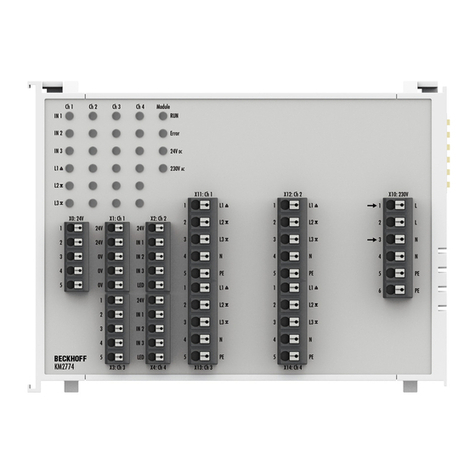
Beckhoff
Beckhoff KM2774 Documentation
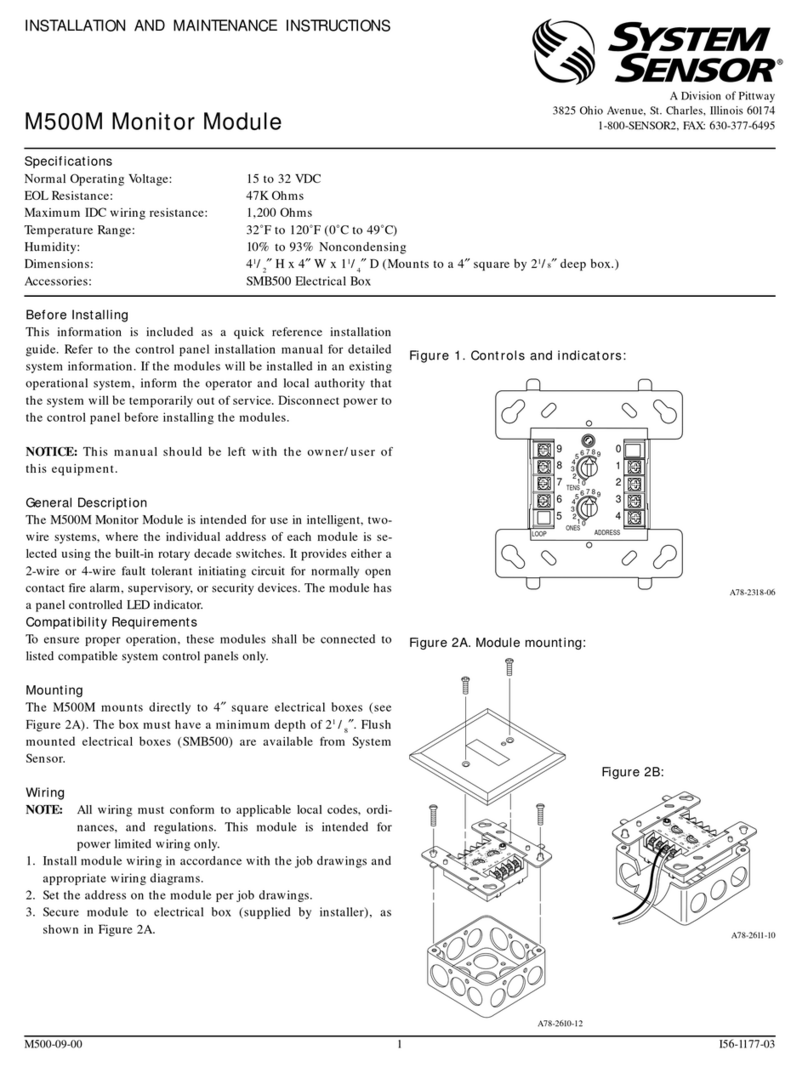
Pittway
Pittway SYSTEM SENSOR M500M Installation and maintenance instructions

Rosendahl
Rosendahl bonsaiLAN instruction manual
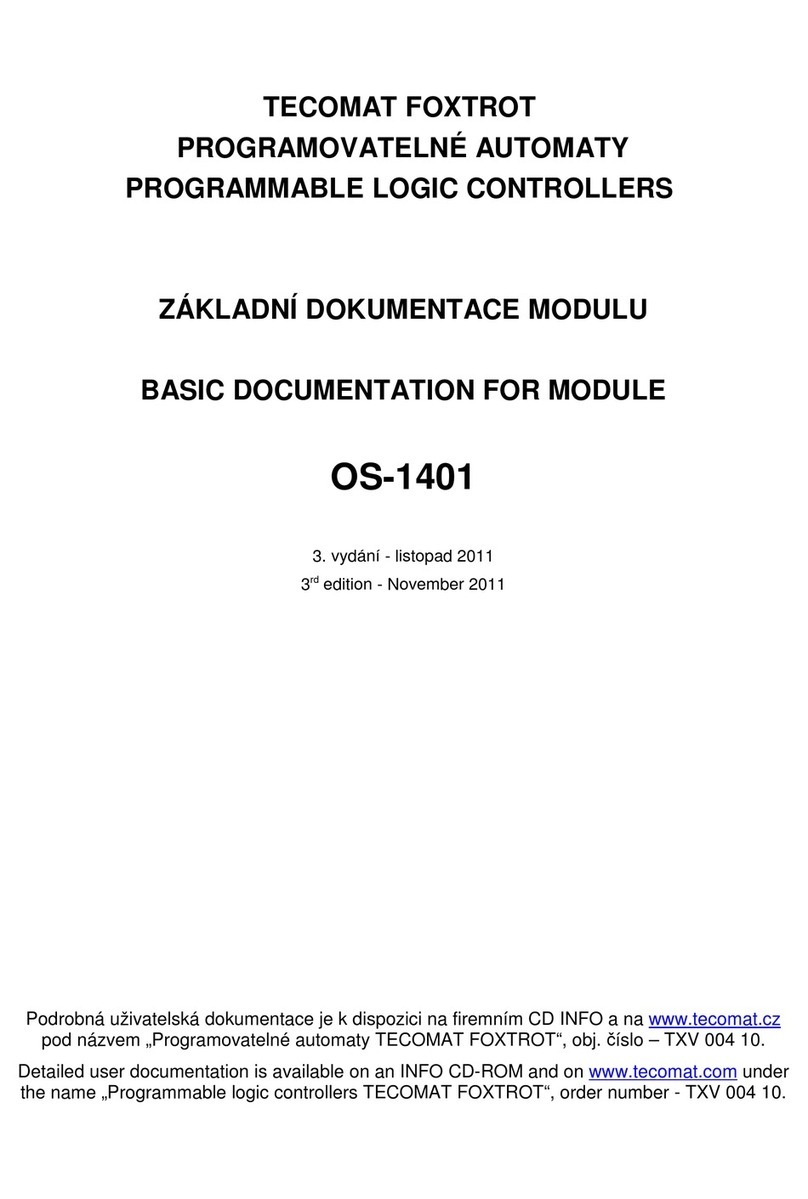
TECO
TECO Tecomat Foxtrot OS-1401 Basic documentation
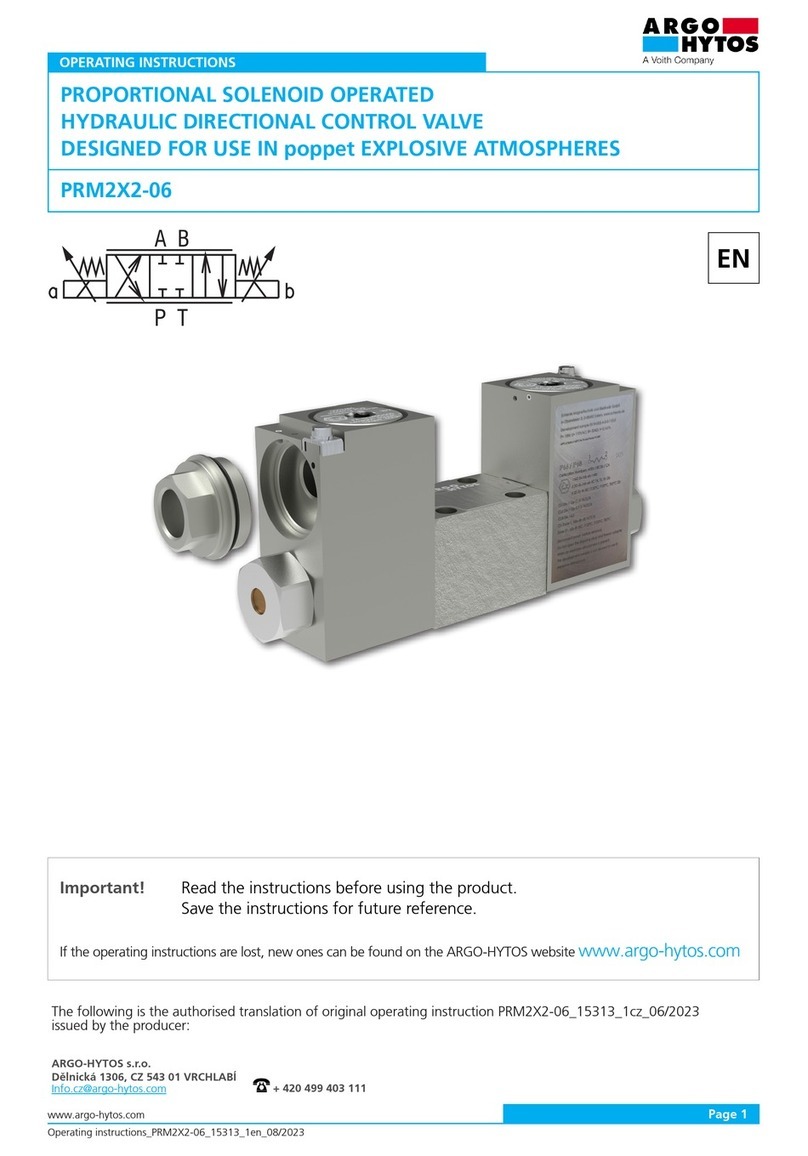
Volth
Volth ARGO HYTOS PRM2X2-06 operating instructions
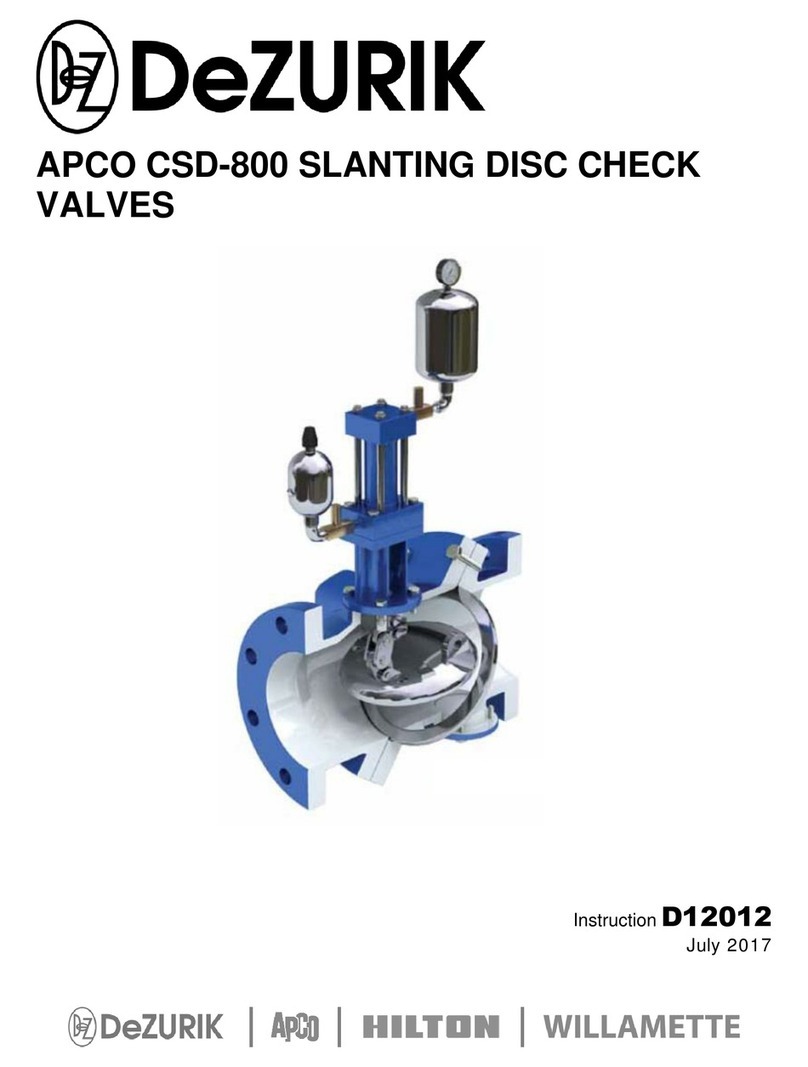
DeZurik
DeZurik APCO CSD-800 user manual
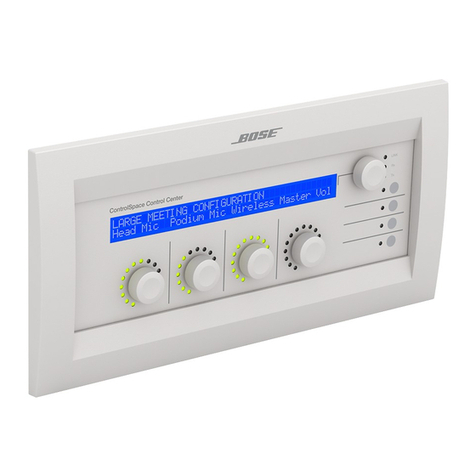
Bose
Bose ControlSpace CC-64 Safety instructions & install guide

CiA
CiA PCM30 quick start guide
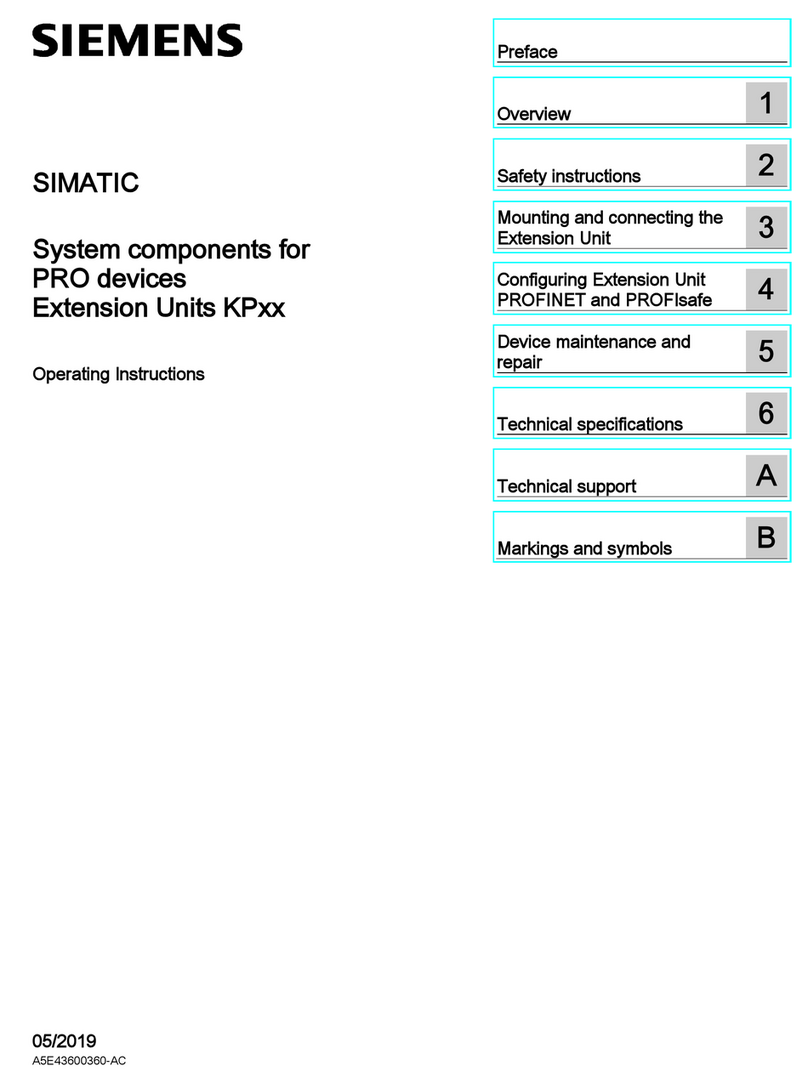
Siemens
Siemens SIMATIC PRO Extension Units KP Series operating instructions
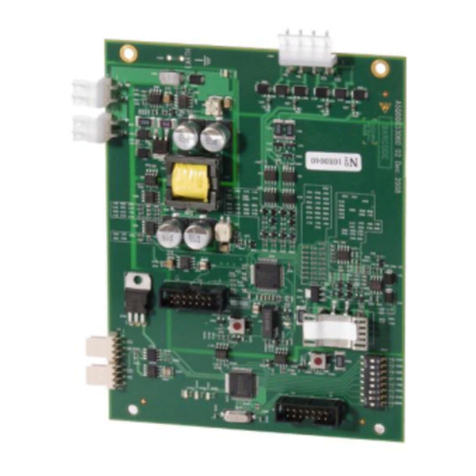
Siemens
Siemens FCI1802-A2 product manual
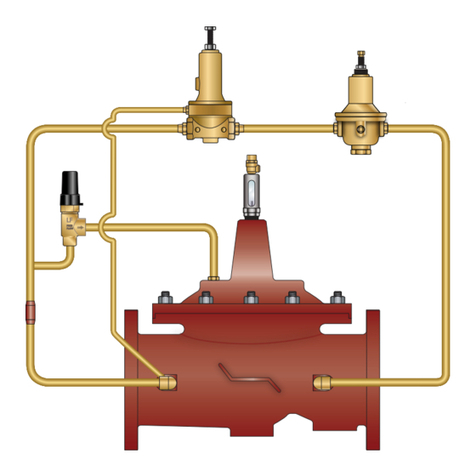
Watts
Watts Ames 912GD Installation operation & maintenance
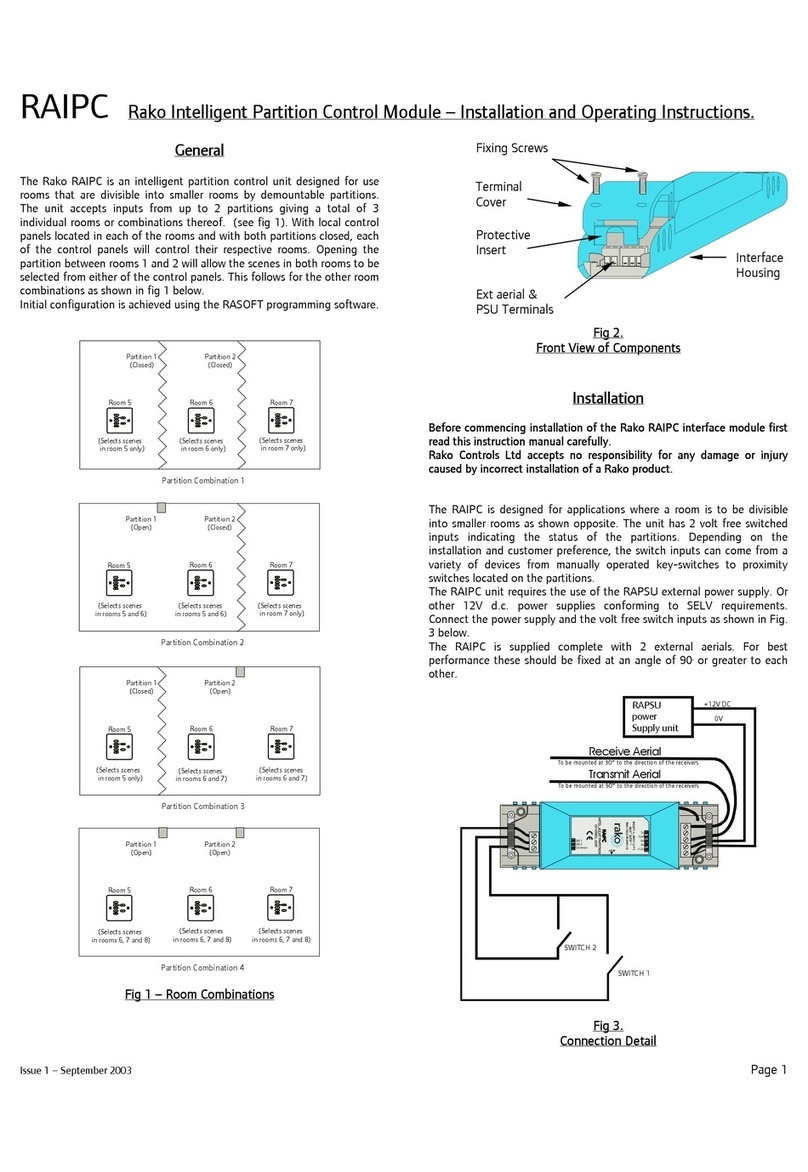
rako
rako RAIPC Installation and operating instructions
